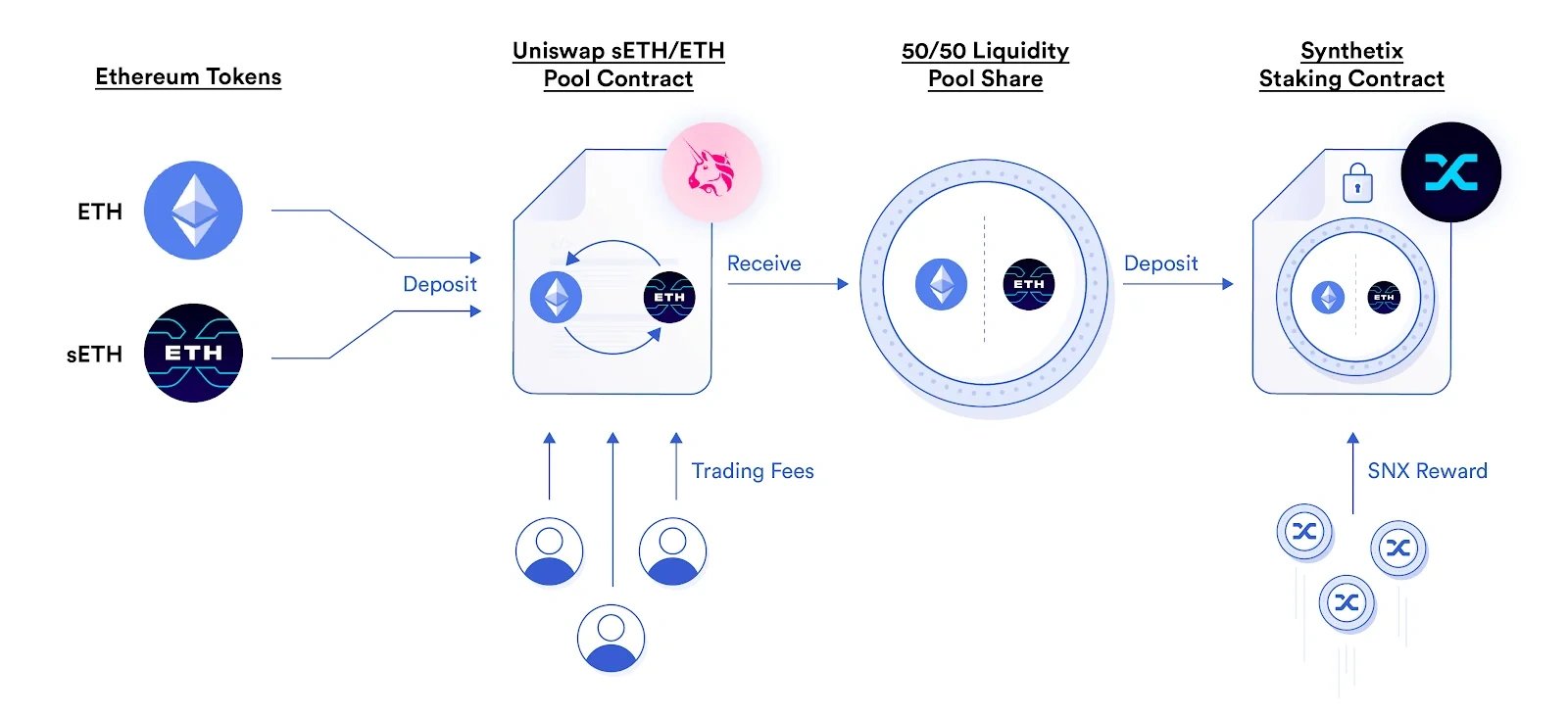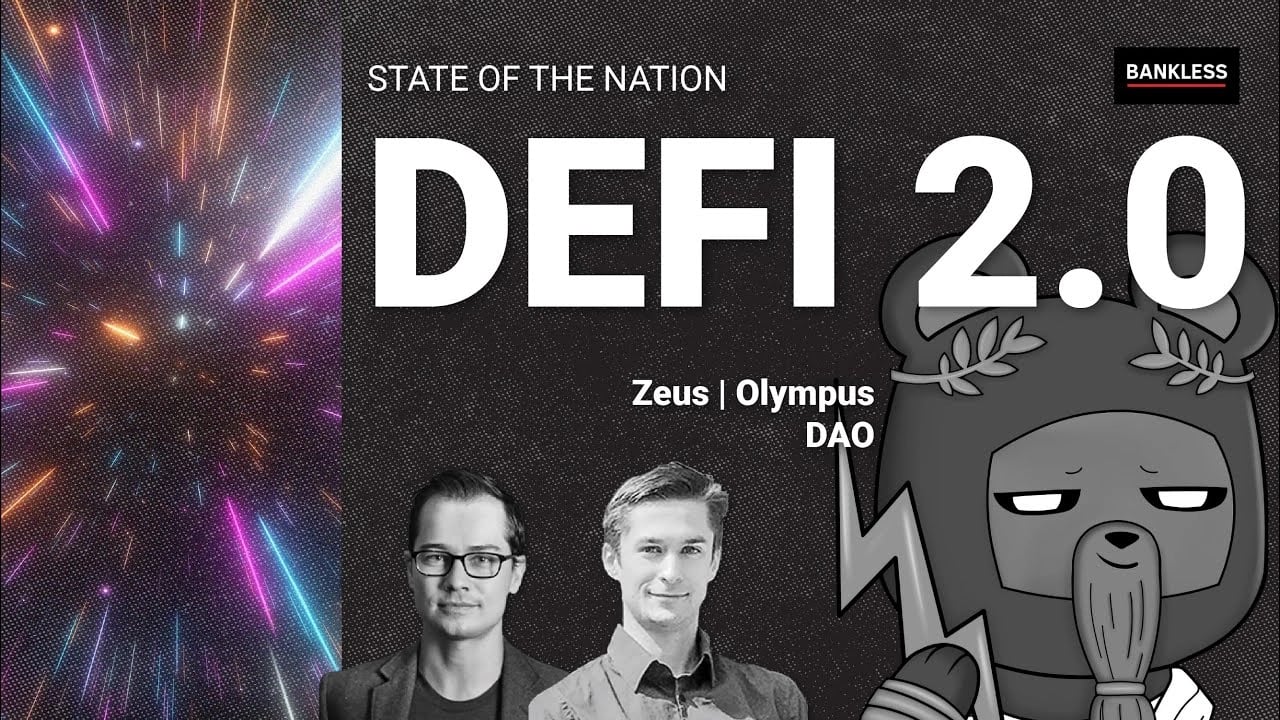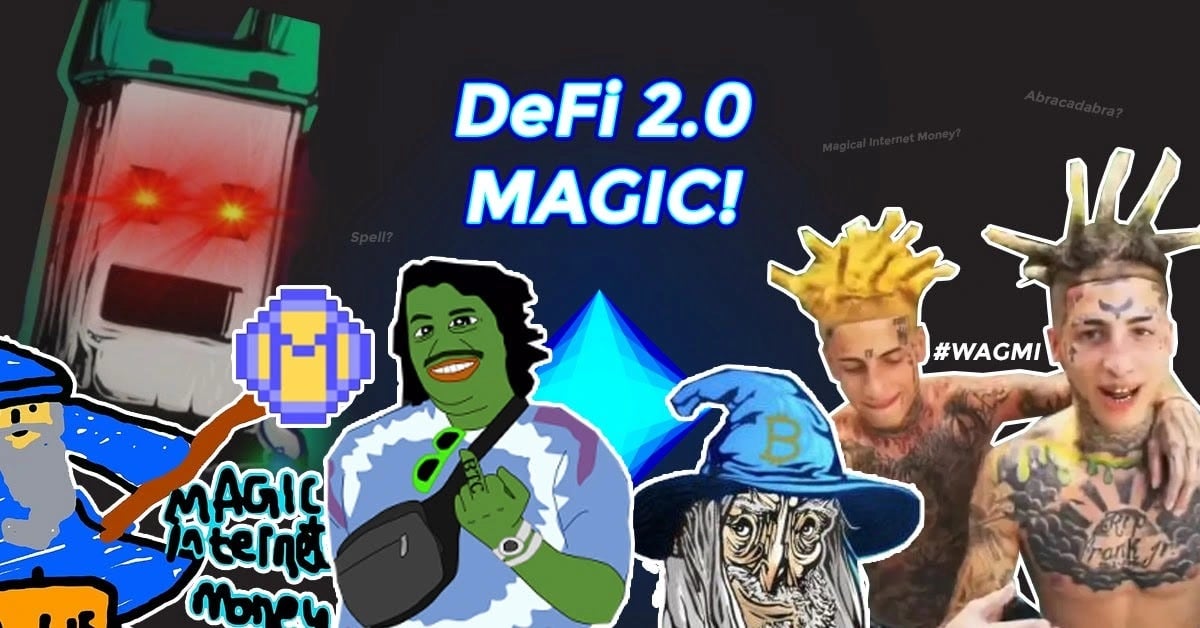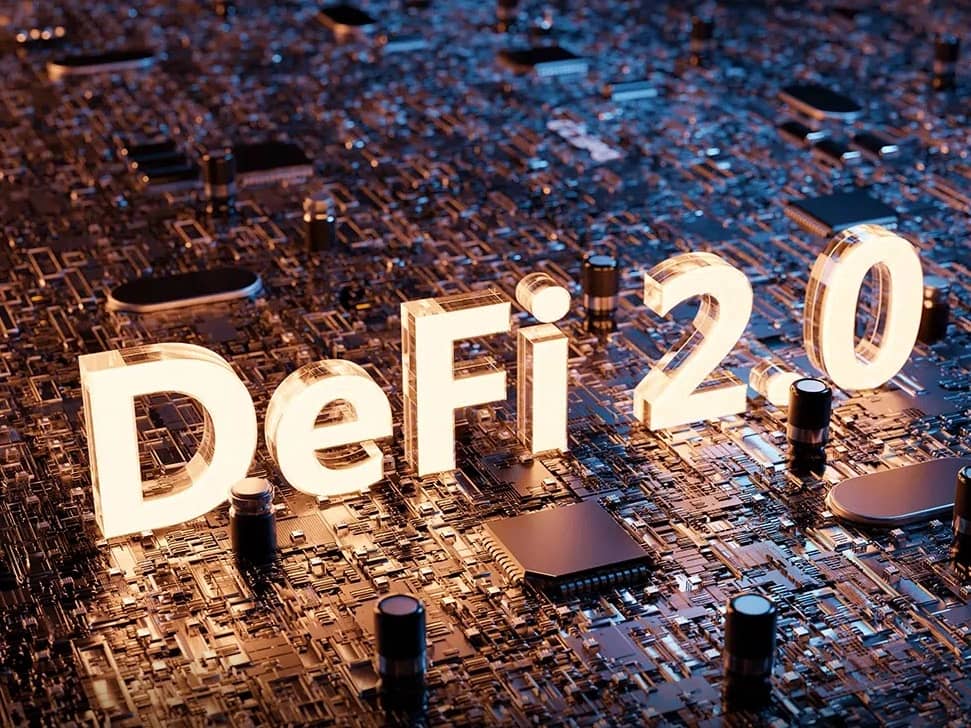위키 구독하기
Share wiki
Bookmark
DeFi 2.0
에이전트 토큰화 플랫폼 (ATP):에이전트 개발 키트(ADK)로 자율 에이전트 구축
DeFi 2.0
DeFi 2.0는 블록체인 세계에서 새롭게 등장한 용어로, DeFi 프로토콜의 하위 집합을 가리키며 수익률 농사, 대출 등 이전 DeFi의 혁신적인 기술을 기반으로 구축되었습니다. 자체 토큰을 가진 많은 온체인 시스템은 유동성 제약을 경험하는데, 이는 주목할 만한 DeFi 2.0 구현의 중요한 초점입니다.[2]
개요
탈중앙화 금융(Decentralized finance, 디파이)는 일반적으로 DeFi로 알려져 있으며, 블록체인 기반 혁신에서 가장 영향력 있고 성공적인 움직임 중 하나였습니다. 블록체인에 내장된 스마트 계약 기능과 체인링크와 같은 안전한 오라클 네트워크를 기반으로 하는 DeFi는 기존의 전통적인 금융 서비스를 중개하지 않고 완전히 새로운 금융 기본 요소를 제공하는 광범위한 탈중앙화 애플리케이션을 의미합니다.[2]
허가 없는 합성 가능성과 오픈소스 개발 문화라는 고유한 장점에 힘입어 DeFi 프로토콜은 금융 기반 계약의 검증된 모델을 지속적으로 발전시키고 반복하고 있습니다. DeFi 생태계는 매우 빠르게 변화하고 있습니다. 지난 몇 달 동안 유동성 중심 DeFi 프로젝트의 증가하는 움직임은 DeFi 2.0으로 일반적으로 알려진 새로운 DeFi 혁신의 물결을 가져왔습니다.[1]
유니스왑(Uniswap), Aave, 뱅코르(Bancor), 메이커다오(MakerDAO), 컴파운드(Compound)와 같은 초기 DeFi 선구자들은 예금에 대한 온체인 수익률과 운영 자본에 대한 허가 없는 접근을 허용하고 생태계에 많은 중요하고 합성 가능한 "머니 레고"를 추가함으로써 급성장하는 DeFi 경제를 위한 견고한 기반을 구축했습니다.
현재 이 부문이 지속 가능해지는 것을 막는 근본적인 문제는 유동성을 확보하기 위한 제3자 제공업체 및 토큰 인센티브에 대한 부문의 의존성, 그리고 DeFi의 전통적인 금융 및 세계 경제와의 상관관계가 사실상 전무하다는 점입니다. DeFi 2.0 이상의 전체 목적은 이러한 문제를 해결하는 것입니다.
DeFi 2.0 운동의 일부 선구자들은 장기적인 유동성을 위한 방법을 개발하는 데 중점을 두고 있습니다.
프로토콜 제어 가치 메커니즘을 구축하는 것은 DeFi 2.0이 탈중앙화 자동화 조직(DAO)(decentralized automated organizations)을 돕는 또 다른 방법입니다.
스테이블코인은 달러, 유로 또는 금 및 기타 암호화폐와 같은 자산 바스켓에 연결된 암호화폐이며, DeFi 운영에 일반적으로 사용됩니다. 그러나 미국 달러에 의해 뒷받침되는 스테이블코인을 사용하는 것이 더 일반적입니다. 반면 DeFi 2.0은 인플레이션 중심 시스템과 규제 위험에 우리를 묶어두고 싶어하지 않기 때문에 "반대"합니다. 일부 플랫폼은 자체 변동 준비금 통화를 발행하여 혁신하고 있습니다. 다시 말해, 올림푸스(Olympus)가 그 예입니다.[6]
DeFi 1.0의 한계
확장성
높은 수수료와 승인된 거래에 대한 긴 대기 시간은 계속해서 사용자 경험에 부담을 주고 있습니다. 알다시피, 대부분의 DeFi 솔루션은 Ethereum블록체인에 구축되어 있으며, 네트워크 사용자 수가 엄청나게 많기 때문에 상당한 지연이 발생하고 거래 비용이 급증하고 있습니다. 결과적으로, 수천 달러 미만의 자산을 가진 사용자는 DeFi 기기를 사용하는 것이 수익성이 없습니다.
결과적으로, 다음과 같은 질문이 제기됩니다. Ethereum의 확장성 문제를 해결하지 않고 사용자가 DeFi를 경험할 수 있는 방법은 무엇일까요?
사용자에게 가장 필요한 것을 제공할 수 있는 블록체인 중 일부인 BSC, Polygon, 및 Solana로 자금이 흘러들어왔습니다. 확장성 문제에 대한 해결책이 다음 시장의 물결을 촉발할 수 있습니다.[2]
제한적인 소비자 보호
DeFi는 탈중앙화 방식으로 피어투피어 네트워크에서 운영됩니다. 따라서 중앙 집중식 금융 시스템처럼 DeFi 사용자를 위한 규칙과 규정이 많지 않습니다. 이러한 엄격한 규제의 부재가 DeFi의 번영에 기여한 측면도 있지만, 이러한 운영 방식에는 심각한 문제점이 있습니다. 예를 들어, 소비자는 잘못된 거래 발생 시 구제받기 어려울 수 있습니다. 반면 중앙 집중식 금융 시스템에서는 사용자와 기관 모두에게 충분한 완충 장치가 마련되어 있습니다. 미국에서는 예를 들어 연방예금보험공사(FDIC)가 은행 파산 시 예금 계좌 소유주에게 기관당 최대 25만 달러를 상환합니다. 은행은 또한 지속적인 안정성을 위해 최소 자본을 준비금으로 보유해야 합니다. DeFi는 이러한 보호 장치를 제공하지 않습니다.[4]
토큰 가격 변경 없이 DEX 및 AMM 사용하기

모든 암호화폐에는 유동성이 필요합니다. 인센티브 프로그램이 일시적인 해결책을 제공할 수 있지만, 이상적인 방법은 아니며 소규모 투자자에게 더 큰 위험을 초래할 수 있습니다.
유동성 문제를 해결하거나 DeFi 시장에 추가 사용자와 자본을 유치하는 가장 간단한 방법은 수익을 얻도록 지원하는 것입니다. AMM 프로토콜의 제3자 유동성 제공자는 유동성 문제에 대한 부분적인 해결책을 제공하여 충분한 자금을 보유한 독립적인 개인이 토큰 쌍에 대한 유동성을 제공할 수 있도록 했습니다.
2020년 여름, 수익 농사(또는 유동성 마이닝으로도 알려짐)가 가능해지면서 블록체인 전문가들에 의해 "DeFi 여름"이라고 불리는 DeFi 활동이 증가했습니다. 수익 농사의 개념은 간단합니다. 사용자는 AMM 프로토콜을 통해 교환 쌍에 대한 유동성을 제공하고, 대가로 LP 토큰을 받은 다음, 프로젝트의 자체 토큰으로 수익을 얻기 위해 LP 토큰을 스테이킹합니다.
이 방법은 제3자 유동성 제공자가 토큰의 더 높은 수익을 제공하도록 강력한 경제적 근거를 제공함으로써 닭과 달걀 문제를 해결합니다. 더 깊은 유동성으로 인해 AMM 스왑에서 누적 수수료가 더 높아지는 것 외에도, 스테이킹을 통해 프로젝트의 자체 토큰을 더 많이 얻어 더 많은 수익을 얻을 수 있습니다.
수익 농사의 등장으로 새로운 DeFi 프로토콜은 상당한 양의 유동성을 부트스트래핑하여 운영을 시작하고 유지하며, 사용자가 자신의 생태계에 진입할 때 미끄러짐을 최소화할 수 있었습니다. 결과적으로 DeFi 프로토콜의 수가 전반적으로 기하급수적으로 증가하여 수익 농사가 사용자와 DeFi 프로젝트 생성자 모두의 진입 장벽을 낮추었음을 보여줍니다.
수익 농사는 DeFi 프로젝트에 대한 자금 조달을 부트스트래핑하는 효과적인 수단임이 입증되었지만, 장기적으로 위험이 없는 것은 아닙니다. 또한 장기적인 수익 농사 프로젝트의 특정 한계로 인해, 그 효과에도 불구하고 유동성 문제를 완전히 해결하지는 못합니다.
대부분의 DeFi 프로젝트는 필요하고 건전하기 때문에 수익 농사 이니셔티브를 수행하고 유동성을 부트스트래핑해야 합니다. 그러나 프로젝트 팀은 부정적인 장기적인 결과를 피하기 위해 토큰 공급과 장기적인 수익 농사 전략에 주의해야 합니다.[2]
중앙화
사람들이 돈을 벌기 위해 DeFi에 참여하는 것 외에도, 자립과 자급자족을 추구하기 위해 DeFi에 참여하기도 합니다. 그럼에도 불구하고 여전히 소수의 그룹이 많은 수의 DeFi 프로토콜을 통제하고 있어, DeFi 사용자들의 신뢰를 잃게 만들고 있습니다.
이 문제를 해결하기 위해 DeFi 프로젝트는 탈중앙화 측면을 우선시하는 경향이 있습니다. 프로젝트의 발전에 대해 누구든 투표할 수 있도록 하는 DAO는 최근 몇 년 동안 폭발적인 인기를 얻었습니다.[2]
비효율적인 자산 사용
특히 암호화폐 분야에서 사람들은 집중 시간이 짧고, 더 큰 금전적 이익을 추구하기 위해 탈중앙화 애플리케이션(DApps)에서 멀어지고 있습니다. 수익률은 예전만큼 매력적이지 않으며, 특히 DeFi의 우량주에 대해서는 더욱 그렇습니다. 이는 반복적인 팜앤덤프 현상을 초래하여 프로젝트의 건전한 현금 흐름을 저해하고 여러 가지 문제를 야기합니다.
DeFi 2.0은 자본 효율성에 중점을 둔 프로젝트를 통해 다음과 같은 작업을 수행할 수 있습니다.
- TVL 최적화: 예치된 자산을 최대한 활용할 수 있도록 합니다.
- 지속 가능한 현금 흐름 창출: 올림푸스 DAO가 보여주듯이, LP 토큰을 채권으로 교환하는 시스템은 팜앤덤프 상황의 빈도를 줄이는 동시에 장기적인 유동성을 제공합니다. 따라서 건전한 현금 흐름을 유지함으로써 프로젝트는 더욱 지속 가능하게 확장하고 더 많은 후원자를 유치할 수 있습니다.[2]
담보화
담보는 대출을 받기 위해 사용되는 가치 있는 물건입니다. 예를 들어, 주택 담보 대출의 담보는 구매하려는 주택일 수 있습니다. 거의 모든 DeFi 대출 거래에는 대출 가치의 100%에 해당하는 담보가 필요합니다. 이러한 제한은 DeFi 대출을 신청할 수 있는 사람뿐만 아니라 대출을 받으려는 사람도 제한합니다.[4]
사용자 경험
DeFi 플랫폼의 사용성 또한 주요 문제입니다. 탈중앙화된 제품은 복잡한 UX와 UI 때문에 사용하기 어렵습니다. 이것이 바로 대다수의 DeFi 활성 사용자가 노련한 암호화폐 애호가인 이유입니다. DeFi 2.0 프로젝트는 DeFi 플랫폼을 더욱 재미있고, 상호 작용적이며, 사용자 친화적으로 만들어 이 문제를 해결하려고 합니다.[4]
DeFi 1.0 vs DeFi 2.0
지속 가능하고 자동으로 분산된 DeFi 2.0 탈중앙화 금융 시스템을 구축하려면 통화 거래가 필요합니다. DeFi 2.0 단계의 탈중앙화 금융은 유동성을 공급하는 모든 커뮤니티 구성원을 연결할 가능성이 더 높습니다. 따뜻하고, 지속 가능하며, 상호 연결된 탈중앙화 금융 아키텍처를 구축하기 위해 모든 미래 거래에서 관계를 연결하도록 유동성 인센티브가 추진되고 있습니다.
DeFi 1.0의 차가운 거래 방식을 깨고, 사용자 간의 긴밀한 수평적 연결을 발전시키는 동시에 강력한 수직적 유대감을 형성할 것을 기대하며, 긴밀한 사용자 관계를 지지합니다.
| DeFi 1.0 | DeFi 2.0 | |
|---|---|---|
| 사용자 간 연결 | 사용자 간 연결 없음 | 사용자 간 강력한 연결 |
| 생태계 | 탈중앙화 중앙 거래 애플리케이션, DEX, 대출 및 스테이블 코인 애플리케이션, 유동성 머신건 풀 애플리케이션, 합성 자산, 그리고 보험 유형 프로젝트 포함 | 따뜻하고, 지속 가능하며, 상호 연결된 탈중앙화 금융 아키텍처 및 자본 효율성을 위한 DAO, 유동성 인센티브 |
| 인센티브 계획 | 사용자에게 매력적이지 않은 제한적인 인센티브 계획 | 사용자에게 100% 보상. 사용자에게 매력적인 인센티브 계획 |
| 거버넌스 패턴 | 체계적이지 않은 커뮤니티 및 부적절한 거버넌스 패턴 | 거버넌스 및 정책 권한은 구성원에게 위임됨 |
| 혁신의 범위 | 일방적인 기술 개발 및 혁신 | 기술 및 금융 혁신의 무한한 범위 |
DeFi 2.0의 장점과 단점
장점
DeFi 2.0은 사용자가 DeFi 공간을 쉽게 사용할 수 있도록 여러 기능을 제공합니다.[5]
- 확장성 향상: DeFi 2.0은 이전 DeFi 프로토콜이 직면했던 확장성 문제를 해결하는 것을 목표로 합니다. 여기에는 사이드체인 및 상태 채널과 같은 2계층 솔루션을 탐색하여 트랜잭션 처리량을 크게 늘리고 비용을 줄이는 것이 포함됩니다.
- 상호운용성 개선: DeFi 2.0은 서로 다른 프로토콜과 블록체인 네트워크 간의 상호운용성을 향상시키는 데 중점을 둡니다. 공통 표준 및 프로토콜을 설정함으로써 다양한 DeFi 플랫폼이 정보를 교환하고 공유하여 원활한 크로스체인 트랜잭션을 가능하게 합니다.
- 보안 강화: DeFi 2.0은 고급 암호화, 공식 검증 기술 및 감사 메커니즘을 구현하여 보안 조치를 강화하는 것을 목표로 합니다. 이는 스마트 계약 취약성과 관련된 위험을 완화하고 해킹 또는 악용 가능성을 줄이는 데 도움이 됩니다.
- 규제 준수: DeFi가 주류의 관심을 받으면서 규제 준수는 중요한 고려 사항이 됩니다. DeFi 2.0은 고객 확인(KYC) 및 자금 세탁 방지(AML) 규정과 같은 규제 요구 사항을 준수할 수 있는 메커니즘과 프로토콜을 도입하려고 합니다. 여기에는 분산형 신원 솔루션을 통합하거나 분산형 규제 프레임워크를 향해 노력하는 것이 포함될 수 있습니다.
- 사용자 경험 향상: DeFi 2.0은 복잡한 프로세스를 단순화하고 사용자 인터페이스를 개선하며 보다 직관적인 도구와 플랫폼을 제공하여 사용자 경험을 향상시키는 것을 목표로 합니다. 이는 기술 전문 지식이 제한적인 개인을 포함하여 더 광범위한 사용자 기반을 유치하고 분산 금융의 채택을 증진할 수 있습니다.
- 금융 상품 다양성 향상: DeFi 2.0은 생태계 내에서 사용 가능한 금융 상품의 범위를 확장하려고 합니다. 여기에는 사용자가 고급 거래 전략과 위험 관리 기술을 활용할 수 있도록 더 정교한 파생 상품, 옵션, 선물 및 기타 복잡한 금융 상품을 개발하는 것이 포함됩니다.
- 분산형 거버넌스: DeFi 2.0은 토큰 보유자 또는 커뮤니티 구성원에게 의사 결정 권한이 분산되는 분산형 거버넌스 모델을 강조합니다. 이를 통해 더 민주적이고 투명한 거버넌스 프로세스가 가능해지고 중앙화된 기관의 영향력이 줄어들고 커뮤니티 참여가 증진됩니다.
- 금융 포용성: DeFi 2.0은 기존 은행 시스템에서 소외되거나 제외된 개인에게 금융 서비스에 대한 접근을 제공함으로써 더 큰 금융 포용성을 촉진할 가능성이 있습니다. DeFi 프로토콜을 통해 사용자는 기존 중개자에 의존하거나 엄격한 자격 기준을 충족하지 않고도 대출, 차입 및 기타 금융 활동에 참여할 수 있습니다.
- 글로벌 접근성: DeFi 2.0은 인터넷에 연결된 모든 사람이 접근할 수 있는 블록체인 네트워크에서 작동합니다. 이러한 글로벌 접근성을 통해 다양한 국가 및 지역의 개인이 분산 금융에 참여하여 진입 장벽을 허물고 글로벌 규모로 금융 기회를 확장할 수 있습니다.
- 투명성 및 감사 가능성: DeFi 2.0 프로토콜은 투명성과 불변성을 제공하는 블록체인 기술을 기반으로 구축됩니다. 모든 트랜잭션과 스마트 계약 상호 작용은 블록체인에 기록되어 공개적인 조사 및 감사가 가능합니다. 이러한 투명성은 신뢰 구축에 도움이 되고 사기 또는 조작의 위험을 줄입니다.
단점
DeFi 2.0에는 많은 장점이 있지만, 다음과 같은 위험도 존재합니다.[5]
- 복잡성: DeFi 2.0은 더욱 고급 기능과 메커니즘을 도입하여 시스템 사용 및 이해의 복잡성을 증가시킬 수 있습니다. 이는 기술적으로 능숙하지 않거나 탈중앙화 금융의 복잡한 내용에 익숙하지 않은 사용자에게 진입 장벽이 될 수 있습니다.
- 중앙화 위험: DeFi 프로토콜이 더욱 상호 연결되고 상호 운용됨에 따라, 소수의 주요 프로토콜이나 플랫폼이 생태계를 지배하는 중앙화 위험이 있습니다. 이러한 권력 집중은 DeFi가 추구하는 탈중앙화 원칙을 훼손할 수 있습니다.
- 규제 문제: DeFi 2.0은 규제 준수를 목표로 하지만, 변화하는 규제 환경을 헤쳐나가는 것은 여전히 어려울 수 있습니다. 탈중앙화 금융을 둘러싼 규제 환경은 불확실하며 관할권에 따라 다릅니다. 모호한 규정이나 불일치하는 집행은 DeFi 생태계 참여자에게 어려움과 법적 불확실성을 야기할 수 있습니다. 규제 당국은 DeFi 혁신의 빠른 속도를 따라잡고 있으며, 탈중앙화 시스템과 기존 규정 간의 불확실성과 잠재적 갈등이 있을 수 있습니다.
- 보안 문제: 보안 강화 노력에도 불구하고, DeFi 2.0은 보안 위험으로부터 자유롭지 않습니다. 스마트 계약 취약성, 코드 악용 및 해킹 시도는 여전히 생태계에 위협이 될 수 있습니다. 지속적인 보안 감사, 강력한 테스트 및 사용자 교육은 이러한 위험을 최소화하는 데 필수적입니다.
- 경제적 및 시장 위험: DeFi 2.0은 더욱 복잡한 금융 상품과 거래 전략을 도입하여 사용자를 더 높은 위험에 노출시킬 수 있습니다. 여기에는 시장 변동성 증가, 유동성 위험 및 예측할 수 없는 경제적 결과가 포함됩니다. 사용자는 DeFi 2.0 프로토콜에 참여하기 전에 이러한 위험을 철저히 이해해야 합니다.
- 사용자 책임 및 보안: DeFi 2.0은 사용자가 자산을 보호하고 적절한 사이버 보안 관행을 유지할 책임을 크게 부담합니다. DeFi의 탈중앙화 특성으로 인해 분실되거나 도난당한 자금을 회수할 중앙 당국이 없으므로 사용자는 인적 오류, 피싱 공격 또는 지갑 취약성에 더 취약합니다. 사용자는 주의를 기울이고 강력한 보안 조치를 취해야 합니다.
- 기존 금융 인프라 통합 부족: DeFi 2.0이 발전함에 따라 기존 은행 시스템, 지불 네트워크 또는 규제 프레임워크와 같은 기존 금융 인프라와의 통합에 어려움을 겪을 수 있습니다. 이는 기존 금융과 탈중앙화 금융 간의 자금 흐름을 원활하게 하지 못하게 하여 광범위한 채택과 상호 운용성에 장벽이 될 수 있습니다.
- 스마트 계약 위험: DeFi 2.0은 금융 운영을 자동화하기 위해 스마트 계약에 크게 의존합니다. 그러나 스마트 계약은 버그나 취약성으로부터 자유롭지 않으며, 작은 코딩 오류라도 상당한 재정적 손실로 이어질 수 있습니다. 스마트 계약의 복잡성은 감지되지 않은 결함의 위험을 증가시키므로 철저한 보안 감사와 신중한 계약 개발이 필요합니다.
탈중앙화
탈중앙화는 새로운 개념이 아니며, 블록체인 기술과 함께 늘 탈중앙화 추세가 있어왔습니다. 기술 솔루션을 구축할 때 일반적으로 중앙화, 분산화, 탈중앙화의 세 가지 주요 네트워크 아키텍처가 고려됩니다. 블록체인 기술은 종종 탈중앙화 네트워크를 사용하지만, 블록체인 애플리케이션 자체는 단순히 탈중앙화되었다고 또는 그렇지 않다고 분류할 수 없습니다. 오히려 탈중앙화는 연속적인 스케일이며 블록체인 애플리케이션의 모든 측면에 적용되어야 합니다.
애플리케이션에서 자원 관리 및 접근을 탈중앙화함으로써 더 크고 공정한 서비스를 달성할 수 있습니다. 탈중앙화는 일반적으로 거래 처리량 감소와 같은 일부 트레이드오프가 있지만, 이상적으로는 트레이드오프가 개선된 안정성과 서비스 수준으로 인한 이점보다 가치가 있습니다. DeFi도 다르지 않습니다. DeFi 1.0의 최초 프로젝트 중 하나인 MakerDAO (DAI)는 이러한 움직임의 표준을 설정했습니다. 이제 프로젝트가 커뮤니티에 제공하는 것이 점점 더 일반적입니다.
- 신뢰할 수 없는 환경 제공: 탈중앙화된 블록체인 네트워크에서는 아무도 다른 사람을 알거나 신뢰할 필요가 없습니다. 네트워크의 각 구성원은 분산 원장 형태로 동일한 데이터의 사본을 가지고 있습니다. 구성원의 원장이 어떤 방식으로든 변경되거나 손상되면 네트워크의 대다수 구성원이 이를 거부합니다.
- 데이터 조정 개선: 기업은 종종 파트너와 데이터를 교환합니다. 이 데이터는 각 당사자의 데이터 사일로에 변환되어 저장되고, 다운스트림으로 전달해야 할 때 다시 나타납니다. 데이터가 변환될 때마다 데이터 손실이나 잘못된 데이터가 워크스트림에 들어갈 가능성이 열립니다. 탈중앙화된 데이터 저장소를 사용하면 모든 엔티티가 데이터의 실시간 공유 보기에 액세스할 수 있습니다.
- 취약점 감소: 탈중앙화는 특정 행위자에 대한 의존도가 너무 높은 시스템의 취약점을 줄일 수 있습니다. 이러한 취약점은 약속된 서비스 제공 실패 또는 자원 고갈, 주기적인 중단, 병목 현상, 양호한 서비스에 대한 충분한 인센티브 부족 또는 부패로 인한 비효율적인 서비스를 포함한 시스템 오류로 이어질 수 있습니다.
- 자원 분배 최적화: 탈중앙화는 또한 약속된 서비스가 더 나은 성능과 일관성으로 제공되도록 하고, 치명적인 실패 가능성을 줄이도록 자원 분배를 최적화하는 데 도움이 될 수 있습니다.
모든 블록체인 프로토콜, 탈중앙화 애플리케이션 (dApp), 탈중앙화 자율 조직 (DAO) 또는 기타 블록체인 관련 솔루션은 다양한 수준의 탈중앙화를 채택합니다. 채택 수준은 일반적으로 솔루션의 성숙도, 시간이 증명한 인센티브 모델 및 합의 메커니즘의 신뢰성, 그리고 창립 팀이 적절한 균형을 맞출 수 있는 능력에 따라 달라집니다. 예를 들어, 많은 DAO는 탈중앙화의 다양한 단계에 있는 다양한 구성 요소를 가지고 있습니다.
많은 플랫폼 토큰은 보유자에게 투표권을 부여하는 거버넌스 토큰으로도 작동합니다. DeFi 2.0이 이 분야에 더 많은 탈중앙화를 가져올 것으로 예상하는 것은 합리적입니다. 그러나 규정 준수 및 규제의 역할은 DeFi를 따라잡으면서 더욱 중요해지고 있습니다.[3][7]
주요 DeFi 2.0 프로젝트
Frax 프로토콜 (Frax Protocol)
프랙스 파이낸스는 최초의 분수 알고리즘 스테이블코인 프로토콜을 도입했습니다. 프랙스 프로토콜은 오픈소스이며, 허가가 필요 없고, 완전히 온체인입니다. 프랙스 프로토콜의 비전은 BTC와 같은 고정 공급 디지털 자산 대신 확장성이 뛰어나고, 탈중앙화된, 알고리즘 화폐를 제공하는 것입니다. 프랙스는 공급의 일부가 담보로 뒷받침되고 일부는 알고리즘적인 스테이블코인입니다. 담보화된 부분과 알고리즘적인 부분의 비율은 시장의 FRAX 스테이블코인 가격에 따라 달라집니다. FRAX가 1달러 이상으로 거래될 경우 프로토콜은 담보 비율을 낮추고, FRAX가 1달러 미만으로 거래될 경우 프로토콜은 담보 비율을 높입니다.[9]
프랙스 생태계에는 스테이블코인을 통합하는 여러 하위 프로토콜이 있습니다.[10]
- 프랙스스왑: 프랙스스왑은 장기간에 걸쳐 대규모 거래를 신뢰할 수 있게 수행하기 위한 임베디드 시간 가중 평균 시장 조성자 (TWAMM)가 있는 최초의 AMM입니다. 완전히 허가가 필요 없으며, 일정 곱셈 불변식을 기반으로 합니다.
- 프랙스렌드(Fraxlend): 프랙스렌드는 신뢰할 수 있고, 허가가 필요 없으며, 비보관식 대출 플랫폼으로, 두 개의 ERC20 토큰 간에 대출 시장을 제공합니다. 각 쌍은 독립적인 시장이며, 누구든 대출 및 차용 활동에 참여할 수 있습니다.
- 프랙스페리(Fraxferry): 프랙스페리는 브리지나 제3자 애플리케이션 없이 여러 블록체인에서 기본적으로 발행된 프랙스 프로토콜 토큰을 전송하는 허가가 필요 없고, 비보관식이며, 안전한 방법입니다.
프랙스 프로토콜은 현재 3개의 스테이블코인을 발행합니다.[10]
- FRAX: 프랙스 스테이블코인은 미국 달러에 고정된 암호화폐 담보 스테이블코인으로, 확장성이 뛰어나고, 신뢰할 수 있으며, 이념적으로 순수한 온체인 화폐입니다.
- FPI: 프랙스 가격 지수(Frax Price Index) (FPI)는 소비재 바스켓(CPI)에 고정된 최초의 스테이블코인으로, 국가 통화와는 별개의 자체 계정 단위를 만듭니다. FPI는 완전히 뒷받침되고 암호화폐 담보화되어 있습니다.
- frxETH: 프랙스 이더(Frax Ether) (frxETH & sfrxETH)는 ETH에 고정된 스테이블코인 및 LST 시스템으로, 스마트 계약에서 WETH를 대체하는 데 사용됩니다. 프랙스 생태계를 활용하고 완전히 암호화폐 담보화되도록 설계되었습니다.
프랙스 프로토콜은 두 개의 토큰으로 관리됩니다.[10]
- 프랙스 쉐어(Frax Share): 프랙스 쉐어 (FXS)는 생태계의 스테이블코인 및 인프라 프로토콜을 관리하기 위해 스테이킹할 수 있는 유틸리티 토큰입니다. FXS 토큰은 전체 프랙스 경제 내에서 다양한 유틸리티와 기능을 가지고 있습니다.
- 프랙스 가격 지수 쉐어(Frax Price Index Share): 프랙스 가격 지수 쉐어 (FPIS)는 FPI 스테이블코인의 새로운 CPI 고정 속성을 고유하게 관리하기 위해 스테이킹할 수 있는 유틸리티 토큰입니다. FPIS는 프랙스 쉐어 (FXS) 토큰과 상호 연결되어 있으며, 두 토큰 모두 유틸리티가 함께 성장합니다.
다른 많은 스테이블코인과 달리, FXS DeFi 2.0 토큰의 공급은 수요와 공급에 따라 변합니다. 시스템의 최종 목표는 BTC와 같은 고정 공급 디지털 자산과 관련된 결점을 극복할 수 있는 확장성이 뛰어나고 탈중앙화된 자산을 도입하는 것입니다.
목표를 달성하기 위해, 이 프로토콜은 가치를 1달러 근처에 고정하기 위해 세계 최초의 분수 알고리즘 모델에 의존합니다. 예를 들어, 스테이블코인이 1달러 이상으로 거래될 경우 알고리즘은 담보 비율을 낮추고, 그 반대의 경우도 마찬가지입니다. FRAX 이전에는 스테이블코인이 법정화폐 담보, 암호화폐로 초과 담보, 담보가 없는 알고리즘의 세 가지 뚜렷한 범주로 나뉘었습니다. 그러나 새로운 모델의 도입으로 이해관계자에게 새로운 패러다임을 테스트할 수 있는 기회가 주어졌습니다.
미래에 가능한 크로스체인 구현을 고려할 때, 포트폴리오에 추가하는 것을 고려해 볼 시점입니다.[8]
Olympus DAO

Olympus는 다른 DAO와 마찬가지로 토큰 보유자가 중요한 결정에 대해 투표할 수 있도록 합니다. OHM 토큰을 스테이킹하면 플랫폼에서 수익을 얻는 데 도움이 될 수도 있습니다. 스테이킹을 통해 사용자는 sOHM 토큰을 얻을 수 있으며, 이는 다른 DeFi 플랫폼에서 사용할 수 있습니다. sOHM 토큰은 소각하여 OHM으로 전환할 수 있습니다.
사용자는 LP 토큰을 생성하고, 이를 사용하여 채권을 발행한 다음, 할인된 가격으로 OHM을 구매할 수 있습니다. 채권 판매는 Olympus DAO 회원이 수익을 얻는 또 다른 방법입니다.[4]
Abracadabra.money

저희 목록에 있는 또 다른 중요한 DeFi 2.0 프로젝트인 Abracadabra.money는 기본적으로 대출 플랫폼입니다. yvUSDC 및 yvWETH와 같은 이자 발생 토큰을 소유하고 있다면, 이를 담보로 하여 달러에 고정된 스테이블코인인 Magic Internet Money(MIM)를 대출하거나 발행할 수 있습니다.
이렇게 하면 사용자는 이자 발생 토큰을 유동 자산으로 전환할 수 있습니다. 플랫폼의 이자율은 안정적이며 대출 금리는 낮습니다. 플랫폼의 거버넌스 토큰은 SPELL이라고 하며, 제안에 대한 투표에 사용할 수 있고, 스테이킹하여 플랫폼 수수료를 획득할 수도 있습니다.[4]
Convex Finance

잘못된 내용이 있나요?
